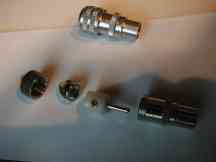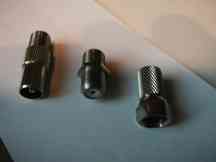 |
 |
 |
 |
TV links
Analogue, digital terrestrial (DVB-T / Freeview) and satellite (DVB-S). Here are a few links I have found useful. See also our Freeview reception tips.
|
News, links, station info, RSL/Satellite/Internet radio info, presenter lists etc. |
|
|
Radio and TV (inc. satellite and digital) news, covering content, transmission and reception. Comprehensive forums. |
|
|
Frequently updated station lists and tuning details for Sky and FTA statelite users. (Frequently updated) |
|
|
Spares, accessories, kits and much info for satellite, Freeview etc. Also several useful e-books |
|
|
Supplier of aerials, dishes, amplifiers and radio/tv distribution kit |
|
|
Digital terrestrial transmitter info. |
|
|
Sky TVs little known subscription free option. |
| Try to avoid unnecessary
connections in the cable and use good quality
plugs and connectors. Standard TV coax plugs (also known as
Belling-Lee plugs) are available in various different types.
Avoid the cheap plastic bodied types, these are highly prone
to bad connections. Aluminium types are much better.
Better still are chrome plated types, as they are less prone
to corrosion, however, where the centre conductor is fixed by means of
a screw, care must be taken that the screw does not short out on the
outer body of the plug. |
 |
| By far the best type of
connector is the F connector. This is
the type used in satellite installations and is both simple and
reliable. With these connectors, the centre conductor of the
cable is used as one pin, the F connector screws or crimps onto the
outer braid and insulation. The F plug then screws securely
to its socket. Where cables have to be joined, use two F
connectors and an F barrel coupler. Where the cable connects
to the standard Belling-Lee connector on the receiver, use an F
connector on the cable, then screw this into an F to Belling-Lee adaptor. |
 |